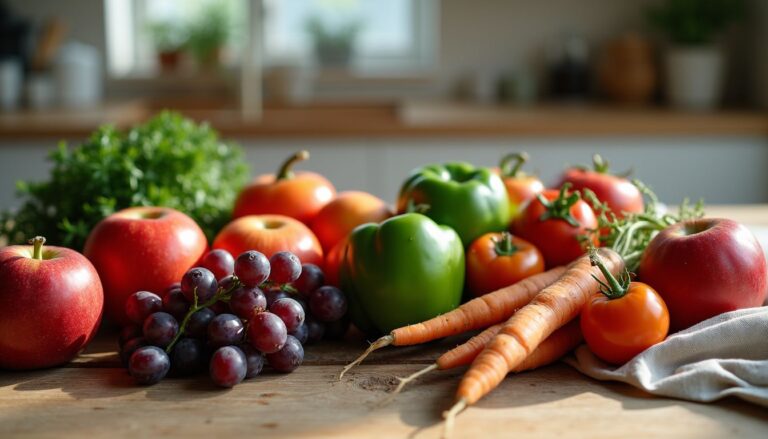Essential Healthy Food List For Optimal Eating Habits
Our Nutrition Assistant AI Suite will transform your body. You will lose fat, get toned, and build muscle. Gain confidence and optimal health.
Healthy eating can feel confusing at the store. Labels compete for your attention, and it is hard to know what matters. A balanced diet built on whole, nutritious foods lowers your risk of heart disease and keeps daily energy steady, according to the Dietary Guidelines for Americans 2020–2025.
This Healthy Food List walks you through fruits, vegetables, proteins, whole grains, and more. You will see practical tips to build an eating plan that fits your life. Use it to choose the foods for health that belong on your plate each day.
Key Takeaways
- Eating a balanced diet with daily servings from all major food groups can lower your risk of heart disease, based on the 2020–2025 Dietary Guidelines for Americans.
- Leafy greens, berries, whole grains, lean poultry, fish rich in omega-3 fats such as salmon, and low-fat dairy help you maximize nutrient intake.
- Regular intake of processed foods and sugary drinks raises the risk of obesity and type 2 diabetes. Whole foods with fiber and antioxidants are the smarter choice.
- Limit red meat to protect cholesterol levels. Include plant proteins like lentils and nuts, plus healthy fats from olive oil or avocado.
- Staying hydrated with water supports metabolism and energy. Herbal teas add antioxidants without extra calories, as shown in recent studies from 2021–2023.

Why is a Balanced Diet Important for Health?

A balanced diet supplies vitamins, minerals, and other nutrients your body needs to work well. The Dietary Guidelines for Americans 2020–2025 encourages you to include each major food group daily.
Different foods offer different benefits. Fruits and vegetables provide fiber and antioxidants, which help protect cells. Dairy products supply calcium for bones. Leafy greens, eggs, small fish with omega-3 fatty acids, legumes such as lentils and beans, and nuts cover more nutrients together than any single food can.
No single food provides every nutrient you need. Variety supports healthy blood pressure with potassium-rich choices like bananas and spinach. Limiting sodium, the salt in many packaged foods, further protects your heart.
A simple change, like adding a colorful salad to lunch most days, can lift afternoon energy. Many people also see cholesterol improve when they cut back on red meat for a few months.
Nutrient synergy means different foods eaten together can boost absorption and support whole-body wellness.
Key Fruits and Vegetables for Optimal Health
You can boost your nutrition by adding more fruits and vegetables such as kale, broccoli, carrots, and tomatoes to daily meals. These foods are high in fiber and vitamins that help protect your circulatory system, the network of blood vessels and the heart, from chronic conditions.
What Are the Best Fruits for a Healthy Diet?
Fruits add color, flavor, and key nutrients to your eating plan. They are a core food group that supports a healthy diet.
- Apples offer fiber, vitamin C, and antioxidants. Regular intake is linked with lower blood pressure and a reduced risk of type 2 diabetes. Keep sliced apples ready for a quick snack.
- Mangos are low in calories and high in fiber plus vitamins A and C. Their natural sweetness makes them kid friendly while supporting immune health.
- Blueberries supply fiber and powerful antioxidants, including resveratrol. They support blood vessel health without added sugar.
- Oranges provide vitamin C and fiber. They also contain antioxidants that can lower the risk of cardiovascular disease. Add wedges to salads or enjoy as a snack.
- Strawberries are low in calories and carbs. They deliver vitamin C, manganese, and fiber. Try them with yogurt or whole grain cereal.
- Bananas are portable and rich in potassium and vitamin B6. They support muscle function after exercise.
- Avocados supply healthy fat, potassium, fiber, and vitamin C with little saturated fat. Mash on whole wheat toast or add to salads.
- Grapes are an easy sweet snack with antioxidants that may lower the risk of chronic disease.
- Kiwis are high in vitamin C and fiber. Their tart taste brightens fruit salads.
- Peaches contribute vitamins A and C and plenty of water, which helps hydration. Eat them fresh in season.
Keep cut berries and apple slices in the fridge. Having these ready makes it easier to choose healthy foods over snacks high in added sugar or saturated fat.
Which Vegetables Should You Include for Maximum Nutrition?
After you build a fruit habit, add nutrient-rich vegetables from several categories. Eating many different vegetables supports optimal eating habits and covers a wide range of vitamins and minerals.
- Broccoli contains glucosinolates, plant compounds that support natural detox processes. Eat it raw or steam for 5–10 minutes to keep nutrients.
- Spinach provides lutein and zeaxanthin, antioxidants that support eye health. Enjoy it fresh in salads or sautéed with olive oil.
- Kale is a nutrient-dense leafy vegetable with antioxidants and fiber. Bake or sauté with onion and garlic for extra flavor.
- Beets, red or golden, offer carotenoids and natural nitrates that can support exercise endurance.
- Carrots deliver vitamin K, fiber, and beta carotene. Eat them raw or lightly steamed.
- Bell peppers come in many colors and are rich in vitamin C and antioxidants that support immunity.
- Garlic contains allicin and other antioxidants that may lower risk for cancer and cardiovascular disease. Add fresh minced garlic to soups or stir-fries.
- Also try asparagus, cauliflower, cucumber, onions, tomatoes, Brussels sprouts, cabbage, celery, eggplant, leeks, lettuce, mushrooms, radishes, squash, Swiss chard, collard greens, turnips, and zucchini to add more variety.
Loading your plate with a mix of these vegetables adds fiber and antioxidants. This supports weight control and fits well into balanced eating patterns.
What Are the Benefits of Eating Whole Grains?
Whole grains such as oats, brown rice, and barley are a good source of fiber and B vitamins. Replacing white bread or refined pasta with whole grains helps steady blood sugar and supports digestive system health.
Which Whole Grains Are the Healthiest Choices?
Whole grains bring essential nutrients and fiber to your diet. Choosing wisely can help manage blood sugar and lower heart risk.
- Brown rice offers more fiber, vitamin B1, and magnesium than white rice. It helps you feel full longer and steadies blood sugar.
- Oats contain beta-glucans, fibers that improve cholesterol and support a healthy gut microbiota, the helpful bacteria in your intestines.
- Quinoa is a gluten-free seed high in protein, magnesium, and fiber. Its low glycemic index helps prevent blood sugar spikes.
- Whole-grain bread delivers more nutrients than white bread. Check labels for whole or sprouted grains.
- Barley is a good source of fiber that supports digestion and may help maintain a healthy body weight.
- Popcorn counts as a whole grain when air-popped without butter. It can be a low-fat snack.
- Whole wheat pasta offers more minerals and fiber than pasta made from refined flour.
- Bulgur wheat is quick-cooking and works well in salads like tabbouleh.
- Wild rice provides protein and vitamins while being lower in calories than many other grains.
Prep overnight oats during busy weeks. This simple routine boosts morning fiber and steady energy.
Lean Proteins for a Stronger Body
Lean proteins help build and repair muscle. Eating from all major food groups, including poultry and plant choices, supports strength and health.
What Poultry Options Provide Lean Protein?
Poultry can deliver protein without much saturated fat when you choose lean cuts and healthy cooking methods.
- Choose skinless chicken breast for high protein with low fat and fewer calories. It also offers potassium and B vitamins for energy.
- Pick white meat poultry such as turkey breast or skinless chicken pieces. These are lower in saturated fat than dark meat.
- Keep portions moderate, about 3 ounces per serving. That matches guidance from the American Heart Association.
- Bake, broil, or grill instead of frying. These methods help limit extra fat and calories.
- Remove the skin before cooking or eating to reduce saturated fat.
- Add sliced chicken or turkey to salads, wraps, or grain bowls for easy meal prep.
- Season baked chicken with spices that add savory, umami flavor to meet Mediterranean-style goals.
Which Fish Are Best for Lean Protein Intake?
Seafood gives you lean protein plus heart-friendly omega-3 fats. Aim for a mix through the week.
- Salmon provides high-quality protein, omega-3 fatty acids, and vitamin D. Include it to meet weekly healthy fat goals.
- Sardines offer protein, calcium, and vitamin D. Choose canned sardines packed in water to limit calories.
- Shrimp are low in fat and calories yet high in protein and zinc for muscle repair.
- Trout delivers benefits similar to salmon with less saturated fat.
- Tuna is rich in protein and low in fat. Pick options labeled low mercury from trusted sources.
- Herring contains omega-3s along with lean protein. Grill or bake for less added fat.
- Mackerel supports heart health with omega-3s and protein. Prepare it broiled or baked to limit sodium.
- Shellfish such as clams and oysters supply lean protein and minerals like zinc. Buy from reputable seafood vendors.
- Target three servings per week, about 3–4 ounces per serving, to support healthy eating patterns and reduce myocardial infarction risk.
Simple fish meals, like baked trout with lemon, often taste great and help you stay active due to their nutrient profile.
What Plant-Based Proteins Should You Eat?
Plant proteins help build muscle and support health with fiber and key minerals. Mix several types across the week.
- Lentils supply about 9 grams of protein per half-cup cooked, plus plenty of fiber for digestion.
- Chickpeas work in salads, soups, or as hummus with herbs for a fast dip.
- Kidney beans bring fiber, vitamins, and minerals. Cook them fully to remove natural toxins found in raw beans.
- Green beans are a lighter side that still contributes vitamins, fiber, and some protein.
- Peanuts contain antioxidants and nutrients. Watch portions since they are high in calories.
- Tofu is versatile. It absorbs flavors and provides complete protein for stir-fries or grilling.
- Peanut butter pairs well with whole grain bread. Keep servings modest due to its calorie density.
Next, see how eggs can fit into a lean protein diet.
How Do Eggs Fit into a Lean Protein Diet?
Eggs are a concentrated source of protein and micronutrients. They rank high in nutrient density, meaning many nutrients for the calories.
- One large egg delivers about 6 grams of protein to support muscle repair and growth.
- You can include up to one egg yolk per day. If you have hypercholesterolemia, a medical term for high cholesterol, consider limiting yolks to four or fewer per week.
- Egg whites contain almost pure protein with no fat or cholesterol. They fit well in many meals, though total portions should match your protein needs.
- Recent reviews from 2023 highlight eggs as nutrient dense, including vitamin B12 and selenium.
- Eggs increase fullness, which can help with weight control.
- Use eggs instead of processed meats or heavy mayonnaise in sandwiches and salads to improve nutrition.
- Try boiling, poaching, or scrambling with spinach or sweet potato for extra fiber and vitamins.
- In healthy people, regular egg intake does not raise blood pressure when part of a varied diet.
- If you follow a low-fat plan, use more egg whites and fewer yolks. Pair eggs with nuts and seeds for balance.
- Check with your clinician or dietitian about the number of eggs that fit your needs.
Sources of Healthy Fats
Healthy fats from nuts, seeds, vegetable oils, and avocados fuel your body and support cell health. Choosing the right types matters more than the total amount.
Why Are Avocados Important in a Healthy Diet?
Avocados deliver healthy fats, fiber, potassium, and vitamin C. They offer plant-based fat that suits vegetarian and vegan eating. They are low in saturated fat and sodium compared to many other high-fat foods.
Avocado intake can raise HDL, the good cholesterol, while not raising LDL, the bad cholesterol. Add slices to salads or spread on toast for breakfast or lunch. Mediterranean-style eating plans often include avocados because they fit well with heart-smart goals.
What Nuts Offer the Most Nutritional Benefits?
Nuts support heart and gut health and may aid weight control because they promote fullness. Choose a small portion most days.
- Almonds provide vitamin E, antioxidants, magnesium, and fiber. A small handful per day is a reasonable serving.
- Walnuts bring fiber, B vitamins, and omega-3 fats that can help lower cholesterol.
- Macadamias are rich in monounsaturated fat, which supports cardiovascular health.
- Brazil nuts are very high in selenium, a mineral that supports thyroid function. One to two nuts often meet daily needs.
- Hazelnuts supply vitamin E and healthy fats that support skin health.
- Eating three or more servings of nuts per week, about 1/2 cup whole nuts or 2 tablespoons nut butter per serving, is linked with lower cancer and heart risks.
- Nuts are calorie dense but filling, which can help limit overeating if you keep portions in check.
Which Seeds Are Considered Superfoods for Health?
Seeds pack fiber, healthy fats, vitamins, and minerals into a small serving. They are easy to add to breakfast bowls, salads, or yogurt.
- Chia seeds are among the best sources of fiber. One ounce delivers about 9.75 grams. They also provide calcium and help you feel full.
- Flax seeds add both soluble and insoluble fiber plus omega-3 fatty acids that support heart health.
- Sunflower seeds provide vitamin E, magnesium, and selenium. They can support healthier cholesterol when used in place of refined snacks.
- Pumpkin seeds contribute protein, iron, magnesium, and zinc for immune support and muscle recovery.
- Hemp seeds are an excellent plant-based protein source and offer essential fatty acids used by every cell.
- Sesame seeds contain lignans, antioxidants that help protect cells. Sprinkle them on salads or grains.
- Poppy seeds add calcium, iron, and fiber. Use them on yogurt or in smoothies.
You can enjoy these seeds alone or mix them into low-fat dairy foods like yogurt or cottage cheese. Next, see why olive and other vegetable oils deserve a spot in your kitchen.
What Are the Health Benefits of Olive and Vegetable Oils?
Extra-virgin olive oil, often called EVOO, is rich in monounsaturated fats and antioxidants. Using 1 to 4 tablespoons per day as your main fat can support heart health.
Mediterranean-style diets often choose EVOO for its antioxidants and favorable fat profile. Other vegetable oils, such as canola or sunflower, offer unsaturated fats that can lower LDL cholesterol when they replace saturated or trans fats. Coconut oil contains medium-chain triglycerides, but use it in moderation since it may raise LDL.
Swapping butter for extra-virgin olive oil often makes meals taste fresher and helps meet daily nutrition goals without adding as much saturated fat.
Essential Dairy Products for Daily Nutrition
Dairy products can add calcium, protein, and vitamin D to your meals. Smart choices support bone strength and a balanced diet.
What Are Healthier Dairy Options to Choose?
Choose low-fat or nonfat dairy to limit saturated fat while keeping protein, calcium, and vitamins.
- Pick low-fat or nonfat milk. One cup provides vitamin D, calcium, and high-quality protein with fewer calories.
- Choose plain yogurt labeled low-fat or nonfat. It supplies probiotics, which are helpful bacteria that support digestion.
- Use lower fat cheeses such as part-skim mozzarella or reduced-fat cheddar. One ounce of cheese offers protein similar to a cup of milk.
- Match total dairy intake to your needs, often 1 to 3 servings per day depending on age, goals, and tolerance.
- If lactose intolerant, select lactose-free products. These still deliver calcium and other key nutrients.
- Unsweetened soy-based alternatives can work well if you avoid cow’s milk. Many offer protein levels similar to dairy without added sugar.
- Add small amounts of flavorful hard cheese to meals in place of processed meats to control saturated fat and sodium.
- Watch flavored yogurts. Many contain syrups that drive sugar intake up fast.
Swapping full-fat ice cream for frozen low-fat Greek yogurt can leave you with more energy after dessert. Small trade-offs like this make healthy eating easier without losing enjoyment.
How Do Yogurt and Cheese Contribute to a Balanced Diet?
Yogurt supports gut health by supplying probiotics, the friendly microbes that help digestion. It also provides calcium and protein found in milk. Nonfat Greek yogurt pairs well with fresh fruit or a few dark chocolate shavings for a quick, satisfying snack.
Cheese is nutrient dense, meaning it packs many nutrients into a small portion. Many people use it to replace some animal protein in salads or home-cooked meals while controlling fat and sodium. Mediterranean-style eating includes both yogurt and cheese in moderation to limit saturated fat and added salt.
Vegetable sticks with a yogurt-based dip offer a simple snack with less processing and fewer additives than many packaged options.
Proper Hydration and Healthy Beverages
Hydration supports every system in your body. Choosing healthy beverages can nourish you beyond a simple glass of water.
Why Is Water Crucial for Daily Hydration?
Water makes up about 60 percent of your body. Every cell uses it for digestion, circulation, and temperature control. You need to replace the water lost through sweat, breathing, and waste each day.
Water is the ideal daily drink because it has no calories, sugar, or additives. Drinking enough can help regulate appetite and support weight goals by helping you feel full before meals. It also helps your kidneys and liver clear waste products.
On busy days or during sports practice, a glass of water can quickly restore focus. If you want variety, unsweetened herbal teas offer flavor and antioxidants without added sugar or artificial ingredients.
What Are Some Healthy Herbal Tea Options?
Herbal and traditional teas can support hydration and add beneficial plant compounds. They are low in calories and work as a substitute for sugary sodas.
- Green tea provides polyphenols, plant antioxidants that support heart health.
- Black tea contains theaflavins that help protect cells from damage and offers gentle energy.
- Chamomile tea is known for a calming effect and may support sleep.
- Peppermint tea can ease digestion and reduce bloating after meals.
- Hibiscus tea provides vitamin C and antioxidants. Early research links it with better blood pressure control.
- Ginger tea may reduce nausea and soothe an upset stomach.
- Rooibos is naturally caffeine free, a good choice in the evening.
- Swapping afternoon snacks for green tea can reduce sugar cravings for many people.
- Many clinicians include herbal teas in Mediterranean-style eating plans due to low calories and supportive plant compounds.
Each tea brings a unique flavor and a simple way to keep your beverage choices light and refreshing.
Other Nutrient-Rich Foods to Include
Several foods deliver extra vitamins and minerals that support your health. Add a few to round out a balanced plate.
What Are the Benefits of Eating Dark Chocolate?
Dark chocolate contains flavonoids, antioxidants that can support heart health when eaten in small amounts. Studies link these compounds with lower blood pressure and improved blood flow.
It also contains resveratrol, an antioxidant also found in red grapes. For exercise recovery, some people choose chocolate milk because it supplies both protein and carbs.
Pair a small square of dark chocolate with Greek yogurt and fruit. This adds fiber and nutrients while keeping portions reasonable.
Which Spices Enhance Health and Nutrition?
Spices do more than add taste. They bring antioxidants and useful plant compounds that support wellness.
- Turmeric contains curcumin, a compound with anti-inflammatory and antioxidant effects.
- Ginger can help digestion and may reduce nausea. It contains gingerol, a powerful antioxidant.
- Cinnamon may improve blood sugar control and can lower cholesterol in some people.
- Cayenne pepper supplies capsaicin, which can boost metabolism and may curb appetite.
- Garlic is rich in allicin, linked with lower blood pressure and cholesterol.
- Black pepper contains piperine, which can increase nutrient absorption, especially with turmeric.
- Cumin provides iron and antioxidants that protect cells.
- Oregano contributes vitamins A, C, E, and K and shows antibacterial activity in lab tests.
- Cloves contain eugenol, an antioxidant that helps reduce oxidative stress.
Sprinkle spices like turmeric, ginger, and cinnamon into soups, grains, or smoothies. You add flavor while keeping salt and fat in check.
Tips for Optimal Eating Habits
Small changes add up over time. Use these practical ideas to make healthy habits stick.
How Can You Diversify Your Diet Effectively?
Choose a range of foods from each food group every day. Rotate fruits like apples, berries, and oranges to boost vitamin and fiber intake.
Alternate leafy greens such as spinach and kale with carrots or bell peppers. Pick whole grains like brown rice, quinoa, oats, and barley instead of white bread or regular pasta.
Mix animal and plant proteins for broader nutrient coverage. Include lean chicken breast along with beans or lentils. Healthy fats matter too, so work in avocados, nuts, and seeds across the week.
Seasonal produce from local markets can add new flavors and may support gut health, according to recent studies. Trying seasonal items often makes meals feel fresh and more enjoyable.
Variety helps prevent nutrient gaps and makes your menu feel less repetitive.
Why Should You Prioritize Whole, Unprocessed Foods?
Whole foods such as fresh fruits, vegetables, and grains deliver nutrients without added sugar or preservatives. Studies from 2022 show they tend to be lower in saturated fat and sodium and higher in fiber, vitamins, and minerals.
Whole foods usually keep you full longer than processed items. That can help with weight management and steady energy.
Swapping packaged snacks for apples or carrots often improves afternoon focus. Diets built mostly on whole foods are linked with lower risks of heart disease and type 2 diabetes.
What Are the Risks of Sugary Drinks and Processed Foods?
Reducing sugary drinks and processed foods cuts excess sugar, unhealthy fats, and high sodium. People who drink soda or juice often have higher risks of obesity, type 2 diabetes, and heart disease. In 2021 research, one sugary beverage per day increased type 2 diabetes risk by up to 26 percent.
Processed snacks like chips and cookies often contain trans fats and extra salt that can raise cholesterol and blood pressure. Mediterranean-style guidelines suggest limiting processed foods to support long-term health.
Many students who replaced soft drinks with water noticed better energy and focus during class. Simple swaps can pay off quickly.
How Does Home Cooking Help Control Ingredients?
Cooking at home lets you control salt, sugar, and fat. You can avoid ingredients that do not suit you and adjust recipes for vegetarian, gluten-free, or low-carb needs.
Home-cooked meals usually contain fewer additives and preservatives than store-bought items. Cooking with friends or family often leads to better choices and stronger habits.
This approach makes it easier to follow a balanced diet and support long-term health goals.
Health Benefits of Eating Nutritious Foods
Nutrient-rich foods help your body perform core tasks well. Many people notice physical and mental benefits within weeks.
How Does Nutrition Boost Energy Levels?
Protein, healthy fats, and complex carbohydrates power steady energy. Whole grains and nutrient-dense foods regulate blood sugar, which reduces sudden energy dips.
Mediterranean-style meals built around fruits, vegetables, lean proteins, and whole grains support focus and stamina. Drinking enough water helps your body transport these nutrients where they are needed.
Athletes often eat oats or brown rice before training because these foods release energy slowly. Similar choices help with long school or work days.
In What Ways Does Diet Strengthen the Immune System?
Fruits and vegetables supply antioxidants and phytonutrients, plant chemicals that protect cells and support immune defense. Vitamin C foods like oranges and strawberries help your body form white blood cells, which target germs.
Omega-3 fats in fish can reduce inflammation and improve immune balance. Fermented dairy like yogurt provides probiotics that support gut health. A healthy gut is closely linked with strong immunity.
Including these foods daily can mean fewer sick days and better protection from common illness.
How Can Healthy Eating Lower Chronic Disease Risks?
A strong immune system is one layer of protection. Healthy eating also lowers risk factors for heart disease, stroke, diabetes, and some cancers.
Mediterranean-style patterns, which feature whole grains, produce, fish and poultry, olive oil, and nuts, are linked with less cardiovascular disease and better brain health with age. Fiber and antioxidants help control cholesterol and blood pressure.
Public health guidance encourages keeping saturated fat under 10 percent of calories, trans fat near zero, sodium under 2,300 milligrams per day, and added sugar as low as you can. These steps support a longer, healthier life.
Foods to Minimize or Eliminate
Some foods make it harder to reach health goals. Cutting back on them can improve your daily nutrition.
Why Should You Reduce Sugary Beverages?
Sugary drinks, such as soda and many juices, add calories without useful nutrients. Studies link high sugar intake with higher risks of obesity, type 2 diabetes, and heart disease, as well as tooth problems.
Choosing water or herbal tea keeps you hydrated without extra sugar. Mediterranean-style eating suggests avoiding sugary drinks and limiting alcohol for better long-term outcomes.
Many people feel more energetic after trading sweet sodas for unsweetened iced herbal tea. The change often reduces cravings for sweets.
What Processed Snacks and Fats Should You Limit?
Limiting processed snacks and unhealthy fats lowers disease risk. Use this list to guide smarter swaps.
- Limit store-bought baked goods such as cookies and pastries to fewer than three servings weekly. Make homemade versions when possible.
- Avoid processed snacks like potato chips and cheese puffs. They are usually high in sodium and unhealthy fats.
- Reduce fatty or processed meats, including sausages, hot dogs, and bacon. These add excess saturated fat and sodium.
- Choose low-fat dairy instead of highly processed cheeses. Plain yogurt or cottage cheese are solid options.
- Skip foods made with partially hydrogenated oils. These contain trans fats that raise LDL and lower HDL cholesterol.
- Minimize fried fast food items such as French fries and fried chicken, which soak up unhealthy oils.
- If you eat red meat, select lean cuts and small portions. Mediterranean-style plans often cap intake at about one serving weekly.
- Pick whole grain snacks instead of refined grains. White bread and sweetened cereals often include added sugar.
- Watch packaged desserts that combine high sugar with added fat.
Cutting back on these items makes room for healthier sources of energy and nutrients.
Building a Sustainable Healthy Eating Plan
You can set yourself up for success with small, steady steps. The following strategies help you keep nutritious foods in your routine.
How Can Meal Prepping Improve Healthy Eating?
Meal prepping means preparing meals and snacks in advance. It helps you control ingredients and portions, which lowers the chance of reaching for fast food on busy days.
Set aside time to chop fruits, wash vegetables, and portion nuts or seeds. Planning breakfast, lunch, dinner, and snacks supports Mediterranean-style goals that feature whole grains, lean proteins, healthy fats, and plenty of produce.
Many people who prep a week of work lunches avoid vending machine choices. Research shows regular meal preparation increases fruit and vegetable intake and improves diet quality over time.
Why Should You Use Seasonal Foods in Your Diet?
Seasonal foods often taste better and may contain more vitamins and minerals. For example, in-season strawberries can have nearly triple the vitamin C of out-of-season imports.
Buying in season can also save money. Many healthy plans highlight local and seasonal ingredients for better flavor and value.
Choosing in-season tomatoes or peaches is an easy way to add variety while supporting local farmers.
When Should You Consult a Dietitian or Nutritionist?
Sometimes expert guidance is the fastest path forward. Reach out to a registered dietitian or nutritionist if you have diabetes, food allergies, digestive disorders, or if you follow vegetarian, vegan, or gluten-free plans.
Dietitians tailor eating plans to your medical history and preferences so changes are safe and effective. Personalized advice often works better than general rules, especially for cholesterol, blood pressure, or weight management.
Ask your healthcare provider for a referral if you need insurance coverage or specialty support.
Conclusion
Using this essential healthy food list can strengthen your eating habits. Fill your plate with colorful fruits, leafy vegetables, whole grains, and lean proteins for steady energy each day. Choose snacks like almonds or chickpeas, drink water often, and pick herbal teas instead of sugary drinks.
Cooking at home gives you control over ingredients and portions, which supports a balanced diet and heart health. As you repeat these choices, they become routine and help protect you from chronic disease.
This content is for educational purposes and is not a substitute for medical advice. For personal recommendations, speak with your healthcare provider or a registered dietitian.
FAQs
1. What foods should I include in an essential healthy food list for optimal eating habits?
A balanced list includes leafy greens such as spinach, whole grains like oats, lean proteins including chicken breast, and fruits such as apples. These foods provide fiber, vitamins, minerals, and protein that support overall health. Studies show diets rich in these items can lower the risk of chronic diseases (Harvard T.H. Chan School of Public Health).
2. How do nutrient-rich foods help improve eating habits?
Nutrient-dense choices supply key nutrients without excess calories or added sugars. For example, broccoli offers vitamin C and fiber with few calories per serving. According to the CDC, people who eat more fruits and vegetables tend to have healthier body weights.
3. Can you give a sample daily meal plan using essential healthy foods?
For breakfast, try oatmeal topped with blueberries; lunch could be grilled turkey on whole wheat bread with lettuce; dinner might feature baked salmon with brown rice and steamed kale; snacks may include carrot sticks or a banana. This approach ensures variety while meeting nutritional needs.
4. Why is it important to follow an evidence-based healthy food list?
Evidence-based lists use scientific research to guide choices rather than trends or opinions alone. Personal experience shows that following proven guidelines helps maintain energy levels throughout the day and supports long-term wellness goals.
Summary: Eating a range of vegetables like kale or carrots along with fruits such as bananas provides vital nutrients for good health; choosing lean meats adds protein while whole grains offer lasting energy benefits supported by research findings.







